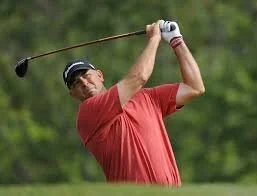The Full Life Of Tom Lehman
“I’m still excited to play,” said Tom Lehman, Minnesota’s greatest player ever. The 1996 (British) Open Champion has won 28 tournaments worldwide, been on three Ryder Cup Teams and three President’s Cup Teams, and was the former number one player in the world. He is not only still committed to his golf game but also the world around him. At 60 years of age his life has evolved into components: golf, family, creativity and volunteer work.
“Golf has caused me to sacrifice a lot of time with my family,” Tom said. “A lot of what I do now is spend time with my wife, Melissa, and family.” Sean is a senior in high school, Thomas, a recent college graduate and aspiring touring professional, Holly and Rachel a new mother. “We’re just like any other family, but without the support of my family I could not have done what I have done.”
The past decade he has missed many Champions Tour events to be home on Friday night to watch Thomas, then Sean, quarterback their high school teams.
Tom started in the golf course design business in 1996. A family friend in the earth moving business wanted to build a golf course. Tom teamed with acclaimed designers Mike Hurdzan and Dana Frey to build Troy Burne, a wonderful course in Hudson, WI. Tom has gone on to partner with other course architects such as John Fought to do great work.
His most highly rated course is The Prairie Club in Valentine, NB, on the list of the Top 100 courses built since 1960.
“I originally wanted to go into architecture at the University of Minnesota. However the School of Architecture wouldn’t allow me to play golf and go to architecture school. I’m really a creative person at heart,” he said as we sat having lunch.
“He was always doing drawings as a kid,” his brother Jim said.
“There is a vast gap between how far the professionals hit the ball today and everybody else. It makes it very difficult for golf course design. There are few courses that can challenge the tour player.” He gazed out at a beautiful Arizona day. “I was recently playing with my son Thomas. I really hit one off the 18th tee. He hit it 67 yards past me to 383 yards!” He paused. “I can’t relate to what they are doing.”
“The challenge with design is all the things that go along with length. How wide should the fairways be. Where are the bunkers?”
He continued. “There are two styles of play: the new which is hit it a mile, be very aggressive, then chip and putt like crazy; and the old which is hit it down the middle, play for position, hit greens.”
“They all hit it very high. The wind does not affect the ball the way it used to.”
“If Phil Michelson would have been playing with today’s equipment and ball through his whole life he would have won 100 times,” he chuckled. “It’s the way he plays, hit it hard, hit it long, be aggressive, chip and putt. He plays the new style as a old guy.”
“Nicklaus was right in the 1990s, they needed to find a way to cut back on the distances for the ball and the driver. However, how do you reign in progress?”
The USGA found out about challenging manufacturers in the Ping law suit, settled in 1990. It was a financial train wreck in legal fees.
After decades in the design business Tom has seen evolution in course design. Early in his design career he built wide fairways with challenging green complexes, featuring deep bunkers. The courses challenged good players around the greens with mounds and sections tucked behind bunkers.
“Today we want to challenge the good players, if we can, but make it fun for everybody else. However, if we can’t do both then we defer to making it fun. We want to have the player find the ball and then have a way to recover. I think it’s what Coore Crenshaw, (a golf course architecture firm), have done, challenging for the good player, but fun for all.”
The recent evolution of design? “Fewer bunkers.”
“We really do good work, but my golf has taken away from the business. There are projects we might be able to get, but don’t because I’m playing.”
The creativity carries over to his 72 acre ranch near Cave Creek, AZ. “It’s a life time project. I have pages and pages of things I want to do up there. The ranch features a 300 yard long fairway with a green at either end, one with creeping bent grass and one with bermuda grass. Several tees up and down both sides of the fairway allow holes of various lengths to be staged. Bunkers surround the greens. It’s a golfers dream practice facility.
Also located on the property are two homes and a large building which can be used for weddings and events. For several years he’s had young aspiring golf professionals, typically from the University of Minnesota, living on the ranch. It’s another aspect of his life, helping young people.
“I got it from my dad. He would have been a great coach. He liked to work with young people. If I could go back in time I would convince him to become a coach.” He looked out the window and back. “When my friends came over to the house they thought my dad was really cool.”
Tom has continued to emulate what he admired in his father. As a founding board member of Elevate Phoenix, “he’s all in”, said Tim Cleary, Executive Director. Elevate Phoenix is a mentoring program working with youth from families in poverty. In the ten years Tom has been involved the program has grown from mentoring 28 kids to 5000 per year.
“He’s the head of our Development Board,” said Tim. “He envisioned a mentoring program that matched our mission. Tom has supported us in every way - time, money, support. It’s not just Tom. Melissa and their kids have all been involved also.”
“98% of our kids graduate from high school, go to college, go into the military or get a job. Statistics say it should be a 50% graduation rate,” Tim said proudly.
In the late ’90s Tom, his brother Jim, and this writer started the Dayton’s Challenge Golf event, raising $4,200,000 for The Children’s Cancer Research Fund at the University of Minnesota. Because of Tom the biggest names in golf, including Jack Nicklaus, Arnold Palmer and Gary Player came to the Dayton’s Challenge. It’s an organization Tom and his wife Melissa still serve as the honorary National Chairpersons.
“The ability to have a positive impact on somebody’s life is a great thing. It can be working on the outside for those on the inside, like the Children’s Cancer Research Fund, or working on the inside like Elevate Phoenix, or working directly as a coach.”
Few weeks go by on tour that Tom does not speak to a Christian organization, giving an uplifting talk to those in attendance.
Favoring a knee for the past decade Tom is working “to get his right knee to function properly. My goal this winter is to develop muscles you need to walk properly,” he said as he flexed his knee.
“I’m excited to play.” Playing golf is a life style for Tom. It’s what life is about. It’s not only the competition but the preparation for competing.
“As long as there is something to look forward to I am going to keep playing the game. Right now I’m looking forward to going to Hualalei on the Big Island for the Mitsubishi Championship in January. The whole family is going.”
“If I am done playing the tour I will look forward to the Friday game here at my club, then having dinner with our friends. Golf is a life style. When I was young the whole family was at the club. Life centered around the club. Times have changed which may be one reason for golf’s popularity leveling off.”
Tom is still close to the University of Minnesota, particularly the Men’s Golf program. “He’s the face of the program,” said Justin Smith, coach of the Gopher Men’s Golf Team. “He’s the best player to ever graduate from the U. When we go to Arizona he’s around, plays golf with us, helps however he can.”
“I am extremely proud of Tom on and off the course,” said brother Jim, a fine player in his own right and Tom’s agent for over 25 years. “Not only his play, but to be a Payne Stewart Award winner.” The Payne Stewart Award is given by the PGA Tour to the player most exemplifying Payne Stewart in values, charitable support and sportsmanship.
Jim Lehman and I watched Tom at the 1996 US Open at Oakland Hills where he was second to Steve Jones and followed him at the 1994 Masters where he was second to Jose Maria Olazabal. The run we had working together on the Dayton’s Challenge tournament and many years of friendship with Tom, Jim and all the members of the Lehman family have been a wonderful addition to A Life In Golf.
Tom and Melissa .






